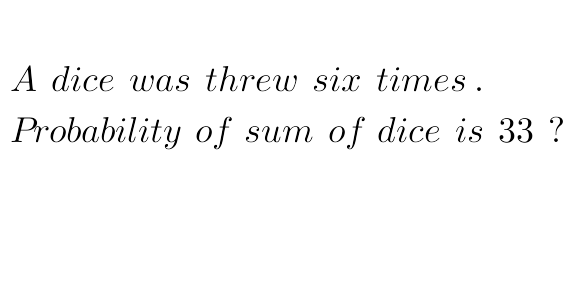
AllQuestion and Answers: Page 1506
Question Number 60690 Answers: 0 Comments: 0
Question Number 60688 Answers: 0 Comments: 0
$${find}\:\int\:\:\:{e}^{−{x}} \sqrt{\frac{\mathrm{3}−{x}}{\mathrm{3}+{x}}}{dx} \\ $$
Question Number 60687 Answers: 1 Comments: 2
Question Number 60685 Answers: 1 Comments: 1
Question Number 60686 Answers: 0 Comments: 0
Question Number 60683 Answers: 0 Comments: 0
Question Number 60682 Answers: 0 Comments: 1
Question Number 60681 Answers: 0 Comments: 1
Question Number 60680 Answers: 0 Comments: 2
Question Number 60679 Answers: 0 Comments: 1
Question Number 60678 Answers: 0 Comments: 3
Question Number 60677 Answers: 0 Comments: 0
Question Number 60676 Answers: 1 Comments: 2
Question Number 60670 Answers: 1 Comments: 2

Question Number 60808 Answers: 1 Comments: 8
Question Number 60675 Answers: 0 Comments: 0
Question Number 60662 Answers: 0 Comments: 0

Question Number 60659 Answers: 1 Comments: 1
Question Number 60658 Answers: 0 Comments: 1
Question Number 60644 Answers: 0 Comments: 0

Question Number 60637 Answers: 1 Comments: 1

Question Number 60636 Answers: 1 Comments: 0
$${Number}\:\:{of}\:\:{different}\:\:{permutation}\:\:{of}\:\:\:{MISSISSIPI}\:\:\:{is}\:\:... \\ $$
Question Number 60635 Answers: 2 Comments: 0

Question Number 60647 Answers: 0 Comments: 3

Question Number 60628 Answers: 0 Comments: 0
Question Number 60620 Answers: 3 Comments: 0
Pg 1501 Pg 1502 Pg 1503 Pg 1504 Pg 1505 Pg 1506 Pg 1507 Pg 1508 Pg 1509 Pg 1510
